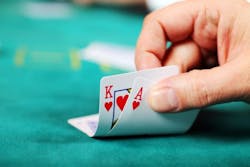Wholesale is obsolete, which you probably know, but how many of the new retail methods have you really embraced?
Indulge me for about 2 minutes for a life-altering, business-changing experience.
Think about the last time you visited a big box store such as The Home Depot, Lowe’s, or Menards, etc.
Seriously. Get it in your mind and get ready to visualize the visit.
Now I want you to re-walk that store in your mind as you answer the following mind-boggling questions.
Question #1. How many aisles did you walk through on that visit? Take your time; see them in your mind, and count them.
Question #2. (This isn’t going to work unless you mentally counted for Question #1. Remember, this is business-changing). So, of the aisles you walked through, from exactly how many aisles did you buy (put in your basket) something?
Question #3. On that last visit, how many times did a store associate ask you if you needed any assistance?
Question #4. On that last visit, how many times did a store associate recommend a product or service outside of what you came into the store for? Example: did a store associate tell you that there was a great paint sprayer sale when you were looking at DeWalt Cordless Tools? (You get the idea).
Question #5. At any time on that visit, did you feel pressured to buy because of something a store associate was saying to you?
Question #6. At any time, did you feel that the store, the business (the big box store), was trying to “sell you something?”
Question #7. Did you at any time feel pressured to buy something while passing through any one of the aisles you visited?
Now, let’s recap, while I revisit my last trip to Lowe’s here in Dalton, Georgia, for some data.
I went to Lowes yesterday because I needed denatured alcohol (for thinning shellac) and epoxy glue.
Q1. I walked through 9 aisles as best as I can remember.
Q2. I purchased items from 3 aisles: (epoxy, denatured alcohol, white shop towels).
Q3. One store associate asked me if I was finding everything alright, and I asked one associate where to find the alcohol. I was quickly pointed in the right direction.
Q4. No store associate recommended any product of any kind.
Q5. At no time did I feel pressured to buy anything.
Q6. At no time did I feel pressured by “Lowe’s,” nor did I feel that they were trying to sell me something.
Q7. At no time anywhere in the store did I feel pressured to buy or do anything.
Remember, we are looking for the newest Fortune 500 methods of retail selling.
The big question is, “Why did I walk through 9 aisles when I only needed to visit 2 aisles?”
I only had two items on my list, therefore, I only needed to visit those two locations; so again, why did I wander over 7 more aisles?
If you can answer this question, you can then analyze your own customer base.
Here’s the reason that I wandered.
#1. I like Lowe’s; I like wandering around shop stuff, building stuff, tool stuff. I just like it.
#2. Big Kahuna! I Wasn’t Sure if I needed something else! (Remember this). While wandering, I remembered I needed shop towels, and that’s when I picked them up.
#3. Because I didn’t feel pressured in any way, I was able to enjoy “looking and wandering” around the store. I also looked at items I will be buying on future visits.
#4. Because the experience was pleasant, and I got what I wanted, I look forward to returning and doing business with them again.
So, I know you are thinking. “What’s so mind boggling about that?”
I am a happy habitual buyer, and I bet you are also.
If your customer wants/needs something fixed, do not try to sell them anything. You want them to feel like they are walking through their favorite store. It is not your responsibility to point anything out, until -- yes, there is a right time. It’s coming.
So, what does the 'retail' call look like?
Greeting the customer respectfully and getting to the diagnosis.
When you have an accurate diagnosis, you present options to the customer. All options must come out of the same aisle, so to speak. If I’m in the denatured alcohol aisle, it’s ok to recommend a better product like a better priced or better quality or better value denatured alcohol, etc., but it’s not ok at this point to say anything about any other item, so to speak, unless you see an obvious (note obvious) problem that must be addressed. Example: the customer says the water heater doesn’t work, and you notice a leaky pipe near the water heater while doing the diagnosis.
“You’ve got to know when to hold ‘em, know when to fold ‘em, know when to walk away, know when to run. You never count your money when you’re sitting at the table; there’ll be time enough for counting, when the dealing’s done.” *
There will be time for upselling; just not yet, and just not selling.
If a store associate comes up to me and tells me that I should look at refrigerators today because they are on sale, my sales resistance, which was not even actively up until now, will be turned on, and I will be resistant to him/ her and the store.
Note: If someone points out an ‘on sale’ item when you are not interested in that item, you think, “Hmm, I wonder what’s wrong with that thing.” However, when you are looking for, say, a refrigerator, and you see that the one you want to buy is on sale, you think, “Hooray! Boy, did I show up at the right time.”
Data: When you try to sell a replacement when they called you for a repair, you run a high risk of offending the customer.
Don’t believe me? Here’s the proof. Well, the proof is in your closing rate if you track it. How many times do you or your technicians go out on a repair call and get sent away with no sale? Yikes.
How do you optimize the customer interaction (meaning service call or sales call)?
Answer: you get their approval for the repair that they called you for today; then you get to work. Then, while you are actively doing the repair, and “if” you “notice” any other repairs they might benefit from, you then offer a “notice.”
Needed or recommended repairs that you “notice” while doing work on what they called you for today can be brought up with virtually no sales resistance.
Lowe’s and other stores have no need to spend money on sales training because they have created a shopping environment that is friendly and welcoming.
Stop and let that sink in. Lowe’s has no sales training, nor does McDonald’s. None.
One Final Question
If these Fortune 500 companies, these successful sales super giants, have absolutely no sales training at all and they sell more per day than we could ever imagine, why do you insist on seeking more sales training for your team, only for it to drive your own team members and customers away?
Can you put the last piece of the puzzle together? Can you see why it works for them?
We already talked zero sales resistance and a pleasant atmosphere. That one final puzzle piece is this: When offering a repair, offer a better repair or maybe a better part; maybe offer a better warranty or maybe a more permanent repair. We do this with menus. Retail stores do this with shelves full of similar items.
Wholesale or retail? The difference is building a get-by business or building wealth.
Rodney Koop
[email protected] / (706)581-0622, call anytime
Pricing enthusiast Rodney Koop is the founder and CEO of The New Flat Rate, a home service menu-selling system designed to put profit directly into the hands of plumbing, electrical, and HVAC contractors.
*"The Gambler', by Don Schlitz. The Gambler lyrics © Sony/ATV Music Publishing LLC
About the Author
Rodney Koop
Founder/CEO
Rodney Koop is the founder and CEO of The New Flat Rate. The New Flat Rate is described as the #1 Pricing System, providing menus for HVAC, plumbing and electrical flat rate service companies, that takes the pressure off the technicians and automatically does the selling.

